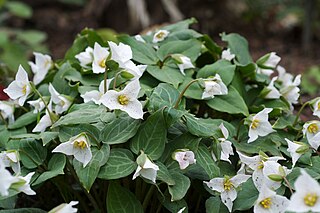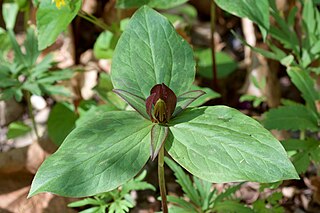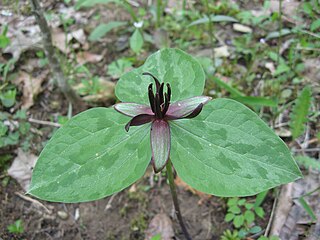
Trillium is a genus of about fifty flowering plant species in the family Melanthiaceae. Trillium species are native to temperate regions of North America and Asia, with the greatest diversity of species found in the southern Appalachian Mountains in the southeastern United States.

Trillium erectum, the red trillium, also known as wake robin, purple trillium, bethroot, or stinking Benjamin., is a species of flowering plant in the family Melanthiaceae. The plant takes its common name "wake robin" by analogy with the European robin, which has a red breast heralding spring. Likewise Trillium erectum is a spring ephemeral whose life-cycle is synchronized with that of the forests in which it lives. It is native to the eastern United States and eastern Canada from northern Georgia to Quebec and New Brunswick.

Trillium grandiflorum is a species of flowering plant in the family Melanthiaceae. A monocotyledonous, herbaceous perennial, the plant is native to eastern North America, from northern Quebec to the southern parts of the United States through the Appalachian Mountains into northernmost Georgia and west to Minnesota. There are also several isolated populations in Nova Scotia, Maine, southern Illinois, and Iowa.

Cornus nuttallii, the Pacific dogwood or mountain dogwood, is a species of dogwood native to western North America from the lowlands of southern British Columbia to the mountains of southern California, with an inland population in central Idaho. Cultivated examples are found as far north as Haida Gwaii. It is a small to medium-sized deciduous tree, reaching 10–25 m tall.

Trillium persistens, the persistent trillium, is a North American species of flowering plants in the genus Trillium of family Melanthiaceae. The plant is also called the persistent wakerobin.

Pseudotrillium is a monotypic genus of flowering plants in the family Melanthiaceae containing the single species Pseudotrillium rivale. The genus was proposed in 2002 on the basis of morphology and molecular evidence that suggest the plant should no longer be included in genus Trillium.

Trillium ovatum, the Pacific trillium, also known as the western wakerobin, western white trillium, or western trillium, is a species of flowering plant in the family Melanthiaceae. It is found in western North America, from southern British Columbia and the tip of southwestern Alberta to central California, east to Idaho and western Montana. There is an isolated population in northern Colorado and southern Wyoming.

Trillium catesbaei, also known as bashful trillium, Catesby's trillium, or bashful wakerobin, is a species of flowering plant in the family Melanthiaceae. It is found in the southeastern United States where its northern limit includes the Great Smoky Mountains and other parts of North Carolina and Tennessee. Its southernmost natural occurrence is in Escambia County, Alabama. Most of its populations are in the Piedmont from North Carolina to Alabama, under deciduous trees such as American beech, various oak and hickory species, and tulip poplar. Like most trilliums, it prefers moist, humus-rich soil in shade.

Trillium luteum, the yellow trillium or yellow wakerobin, is a species of flowering plant in the bunchflower family Melanthiaceae with native populations in the Great Smoky Mountains of the United States and surrounding areas.

Trillium sessile, known as toadshade, sessile trillium, sessile-flowered wake-robin, and toad trillium, is a perennial spring wildflower native to the central part of the eastern United States and the Ozarks. Toadshade can be distinguished from other Trillium species by its single, foul smelling, stalkless, flower nestled in the middle of its three bracts. The bracts are sometimes, but not always mottled with shades of light and dark green. The specific epithet comes from the Latin word sessilis which means low sitting, referring to its stalkless flower.

Trillium cernuum is a species of flowering plant in the family Melanthiaceae. It is the most northerly occurring species of Trillium in North America, occurring as far north as Hudson Bay. Its range extends across Canada, from Saskatchewan in the west to Newfoundland in the east, and as far south as northern Virginia. It occurs on rich, moist soils in both broadleaf and coniferous woodland.

Trillium vaseyi, the sweet wakerobin or sweet beth, is a spring flowering perennial plant which is found only in the southeastern United States, primarily in the southern part of the Appalachian Mountains but with a few populations farther south.

Trillium stamineum, the twisted trillium, also known as the Blue Ridge wakerobin, is a species of flowering plant in the family Melanthiaceae. It is native to the southeastern United States, in Alabama, Mississippi and Tennessee. Its natural habitat is calcareous woodlands.

Trillium pusillum is a species of flowering plant in the family Melanthiaceae known by the common names dwarf trillium, least trillium and dwarf wakerobin. It is native to the southeastern and south-central United States from Oklahoma to Maryland.

Trillium albidum, also known as giant white wakerobin, white toadshade, and sweet trillium, is a species of flowering plant in the family Melanthiaceae. The species is endemic to the western United States, ranging from west central California through Oregon to Washington. It is found in diverse habitats, on the moist slopes of mixed deciduous-coniferous forests, among shrubs and thickets, and along stream banks and river beds.

Trillium recurvatum, the prairie trillium, toadshade, or bloody butcher, is a species of perennial herbaceous flowering plant in the family Melanthiaceae. It is native to parts of central and eastern United States, where it is found from Iowa south to Texas and east to North Carolina and Pennsylvania. It grows in mesic forests and savannas, often in calcareous soils. It is also known as bloody noses, red trillium, prairie wake-robin, purple trillium, and reflexed trillium, in reference to its reflexed sepals.

Trillium petiolatum, the Idaho trillium, also known as the long-petioled trillium or round-leaved trillium, is a species of flowering plant in the family Melanthiaceae. It is native to the northwestern United States, in Idaho, Oregon, and Washington. The type specimen for this species was gathered by Meriwether Lewis in 1806 along the Clearwater River during the return trip of the Lewis and Clark Expedition.

Trillium gracile, commonly known as the Sabine River wakerobin, slender trillium, or graceful trillium, is a species of flowering plant in the family Melanthiaceae. It is native to the region along the Sabine River in western Louisiana and eastern Texas. It generally grows in mature pine and hardwood forests, and on riverbanks.

Trillium kurabayashii, the giant purple wakerobin, is a species of flowering plant native to the United States, in southwestern Oregon and northern California.

Trillium camschatcense is a species of flowering plant in the family Melanthiaceae. It is found in the moist forests of East Asia, in Japan, Korea, China, and eastern Russia.



















